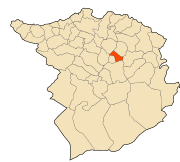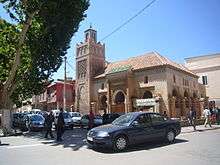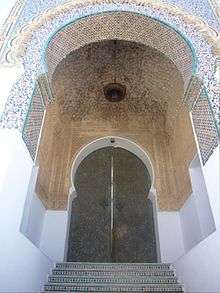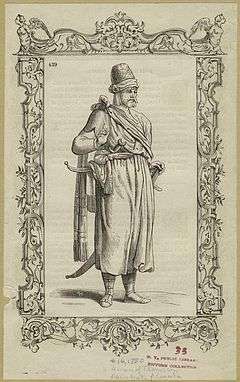Tlemcen
Coordinates: 34°52′58″N 1°19′00″W / 34.8827758°N 1.3166696°W
| Tlemcen تلمسان / Tlemsan / ⵜⵍⴻⵎⵙⴰⵏ | |
|---|---|
| City | |
 Location of Tlemcen in the Tlemcen Province | |
 Tlemcen Location of Tlemcen in the Tlemcen Province | |
| Coordinates: 34°52′58″N 01°19′00″W / 34.88278°N 1.31667°W | |
| Country |
|
| Province | Tlemcen |
| District | Tlemcen District |
| Area | |
| • Total | 9,061 km2 (3,498 sq mi) |
| Elevation | 842 m (2,762 ft) |
| Population (2008 census) | |
| • Total | 173,531 |
| • Density | 19/km2 (50/sq mi) |
| Postal code | 13000 |
| Website |
citedetlemcen |



Tlemcen (Berber: Tlemsan or Třemsan; Algerian Arabic: تْلمسان, Tlemsan; Arabic: تلمسان Tilimsān) is a city in north-western Algeria, and the capital of the province of the same name. The city has developed leather, carpet, and textile industries, which it ships to the port of Rashgun for export. It had a population of 140,158 at the 2008 census, while the province had 949,135 inhabitants.[1]
Etymology
The origin of the name Tlemcen (Berber and Algerian Arabic: Tlemsan) is uncertain, but the word has a Berber structure. One theory traces the name to the Berber words Tala Imsan which means "the dry spring". The name is sometimes spelled Tlemsen, Tlemsan, or Tilimsen.
The town is the ancient capital of central Maghreb, and was founded by the local Berbers.
Culture

Its centuries of rich history and culture have made the city a center of a unique blend of music and art. Its textiles and handcrafts, its elegant blend of Berber and Arab-Andalusian cultures, and its cool climate in the mountains have made it an important center of tourism in Algeria. It is home to a beautiful tomb - that of Sidi Boumédiène, whose tomb adjoins to a mosque. The Great Mosque at Tlemcen was completed in 1136 and is said to be the most remarkable remaining example of Almoravid architecture.[2]
History
Early years
Tlemcen was founded by the Romans in the 2nd century CE under the name of Pomaria as a military outpost. It was an important city in North Africa see of the Roman Catholic Church in the century in which it was built, where it was the center of a diocese. Its bishop, Victor, was a prominent representative at the Council of Carthage in 411, and its bishop Honoratus was exiled in 484 by the Vandal king Huneric for denying Arianism. It was a center of a large Christian population for many centuries after the city's Arab conquest in 708 AD.
In the later eighth century and the ninth century, the city became a Kingdom of Banu Ifran of the Kharijite sufri.[3] These same Berber Kharijis also began to develop various small Saharan oases and to link them into regular trans-Saharan caravan routes terminating at Tlemcen—beginning a process that would determine Tlemcen's historical role for almost all of the next millennium.[4]
In 1082 the Almoravid leader Yusuf ibn Tashfin founded the city of Tagrart ("Encampment" in the Berber language), which merged with the existing settlement, now called Agadir and since then became known as Tlemcen (Tilimsan). Tlemcen probably passed from Almoravid to Almohad control in the mid-twelfth century. However, in the early thirteenth century, Ibn Ghaniya attempted to restore Almoravid control of the Maghreb. In about 1209, the region around Tlemcen was devastated by retreating Almoravid forces, not long before their final defeat by the Almohads at the Battle of Jebel Nafusa in 1210.[5] Despite the destruction of Tlemcen's already-feeble agricultural base, Tlemcen rose to prominence as a major trading and administrative center in the region under the succeeding reign of the Almohads.
Kingdom of Tlemcen
On the collapse of Almohad rule in the 1230s Tlemcen became the capital of one of three successor states, the (Ziyyanid) kingdom of Tlemcen (1236 - 1554) and was ruled for centuries by successive Ziyyanid sultans.[6] Its flag was a white crescent pointing upwards on a blue field. During the Middle Ages, Tlemcen not only served as a trading city connecting the "coastal" route across the Maghreb with the trans-Saharan caravan routes,[7][8] but also housed a European trading center (funduk) which connected African and European merchants.[9] In particular, Tlemcen was one of the points through which African gold (arriving from south of the Sahara via Sijilmasa or Taghaza) entered the European hands.[10] Consequently, Tlemcen was partially integrated into the European financial system. So, for example, Genoese bills of exchange circulated there, at least among merchants not subject to (or not deterred by) religious prohibitions.[11]
At the peak of its success, in the first half of the fourteenth century, Tlemcen was a city of perhaps 40,000 inhabitants.[12] It housed several well-known madrasas and numerous wealthy religious foundations, becoming the principal intellectual center of the central Maghreb. At the souq around the Great Mosque, merchants sold woolen fabrics and rugs from the East, slaves and gold from across the Sahara, local earthenware and leather goods, and a variety of Mediterranean maritime goods "redirected" to Tlemcen by corsairs—in addition to the intentional European imports available at the funduk.[13] Merchant houses based in Tlemcen, such as the al-Makkari maintained regular branch offices in Mali and the Sudan.[14][15]
Later in the fourteenth century, the city twice fell under the rule of the Marinid sultan, Abu al-Hasan Ali (1337–48) and his son Abu 'Inan. In both cases, the Marinids found that they were unable to hold the region against local resistance.[16] Nevertheless, these episodes appear to have marked the beginning of the end. Over the following two centuries, Zayyanid Tlemcen was intermittently a vassal of Irfiqiya (then governed by the Hafsid dynasty), Maghrib al-Aksa (then governed by the Marinid dynasty), or Aragon.[17] When the Spanish took the city of Oran from the kingdom in 1509, continuous pressure from the Berbers prompted the Spanish to attempt a counterattack against the city of Tlemcen (1543), which was deemed by the Papacy to be a crusade. The Spanish failed to take the city in the first attack, although the strategic vulnerability of Tlemcen caused the kingdom's weight to shift toward the safer and more heavily fortified corsair base at Algiers.
The ruler of Tlemcen is reported to have been advised by a Jewish viceroy named Abraham, who, in the time of the Inquisition of Torquemada, opened the gates of Tlemcen to Jewish and Muslim refugees fleeing Spain. Abraham is said to have supported them with his own money and with the tolerance of the king of Tlemcen.
Later years
In 1554, the kingdom of Tlemcen came under Ottoman rule, which deposed the Zayyanid dynasty. The Ottomans were fighting a naval war against the Spaniards across the Mediterranean, and the Kingdom of Tlemcen became another vassal of the Sultan in Constantinople. Tlemcen and the Algerian provinces regained effective independence in their own affairs in 1671, although Tlemcen was no longer a government seat as before. The Spanish were evicted from Oran in 1792, but thirty years later they were replaced by the French, who seized Algiers. A French fleet bombarded Algiers in 1830, at which point the dey capitulated to French colonial rule; a broad coalition of natives continued to resist, coordinated loosely at Tlemcen. The great Berber leader Abd al-Kader, fought with incredible skill and valor, but his defeat in 1844 at Isly ended the dream of a new independent Algeria.
Tlemcen was a vacation spot and retreat for French settlers in Algeria, who found it to be far more temperate than Oran or Algiers. The city adapted and became more cosmopolitan, with a unique outlook on art and culture, and its architecture and urban life evolved to accommodate this new sense. In the independence movements of the mid-twentieth century, it was relatively quiet, reflecting the city's sense of aloofness from the turbulence of Algiers.
Transport
It is served by the international Zenata airport.
Demographics
The population of Tlemcen is divided between Hadars, who are descendent of the Moors, and the Algerian Turks (also known as the "Kouloughlis"), who are the descendents of the Ottoman Turkish settlers.[18]
Notable people
- Ahmed Mohammed al-Maqqari (1591-1632), historian
- Eugénie Buffet (1866-1934), French singer
- Larbi Bensari (1867-1964), musician
- Henri Dickson (1872-1938), French singer
- Cheikha Tetma (1891-1962), musician
- Messali Hadj (1898-1974), nationalist politician
- Hocine Benachenhou (1898-1979), political revolutionary
- Abdelhalim Hemche (1906-1979), painter
- Abdelhamid Benachenhou (1907-1976), historian
- Paul Bénichou (1908-2001), French writer and historian
- Abdelkrim Dali (1914-1978), musician
- Mohammed Dib (1920-2003), writer
- Benaouda Benzerdjeb (1921-1956), physician and martyr
- Bachir Yellès (b. 1921), painter
- Djilali Sari (b. 1928), sociologist and historian
- Abdelmadjid Meziane (1929-2001), scholar and theologian
- Kamel Malti (b. 1929), musicologist [19]
- Choukri Mesli (b. 1931), painter
- Marie-Claude Gay (b. 1942), French novelist
- Mourad Medelci (b. 1943), politician
- Rachid Baba Ahmed (1946-1995), singer and composer
- Sami Naïr (b. 1946), political philosopher
- Emile Malet (b. 1947), French journalist and writer
- Latifa Ben Mansour (b. 1950), writer
- Patrick Bruel (b. 1959), French actor and singer
- Mohamed Zaoui (b. 1960), boxer
- Kherris Kheireddine (b. 1973), international footballer
- Anwar Boudjakdji (b. 1976), international footballer
- Kamel Habri (b. 1976), international footballer
- Dahlab Ali (b. 1976), international footballer
- Zaki Allal (b. 1987) physician, artist and entrepreneur
International relations
Twin towns — sister cities
Tlemcen is twinned with:
See also
- Great Mosque of Tlemcen
- Tlemcen Province
- WA Tlemcen
- Tlemcen National Park
- Zenata – Messali El Hadj Airport
- El-Ourit Waterfalls
- Pomaria
References
- ↑ "Tlemcen: Administrative Units". GeoHive. Retrieved 8 December 2012.
- ↑ M. Talbi (1997), The Spread of Civilization in the Maghrib and its Impact on Western Civilization, in Joseph Ki-Zerbo & Djibril T Niane (eds.) (1997), General History of Africa, vol. IV: Africa from the Twelfth to the Sixteenth Century (abridged ed.) UNESCO, James Curry Ltd., and Univ. Calif. Press., pp. 24-33.
- ↑ Ibn Khaldun, History of Berber
- ↑ Cedric Barnes (2006), Kharijis (768 CE), in Josef W Meri (ed.), Medieval Islamic Civilization: an Encyclopedia. Routledge., p. 436.
- ↑ O. Saidi (1997), The unification of the Maghrib under the Almohads, in Joseph Ki-Zerbo & Djibril T Niane (eds.) (1997), General History of Africa, vol. IV: Africa from the Twelfth to the Sixteenth Century (abridged ed.) UNESCO, James Curry Ltd., and Univ. Calif. Press., pp. 8-23.
- ↑ Delfina S. Ruano (2006), Hafsids, in Josef W Meri (ed.), Medieval Islamic Civilization: an Encyclopedia. Routledge., p. 309.
- ↑ I. Hrbek (1997), The disintegration of political unity in the Maghrib, in Joseph Ki-Zerbo & Djibril T Niane (eds.) (1997), General History of Africa, vol. IV: Africa from the Twelfth to the Sixteenth Century (abridged ed.) UNESCO, James Curry Ltd., and Univ. Calif. Press., pp. 34-43.
- ↑ S.M. Cissoko (1997), The Songhay from the twelfth to the sixteenth century, in Joseph Ki-Zerbo & Djibril T Niane (eds.) (1997), General History of Africa, vol. IV: Africa from the Twelfth to the Sixteenth Century (abridged ed.) UNESCO, James Curry Ltd., and Univ. Calif. Press., pp. 77-86.
- ↑ Talbi (1997: 29).
- ↑ Id.
- ↑ Fernand Braudel (1979), Civilization and Capitalism, 15th-18th Century: Vol. III: The Perspective of the World. Transl. Sian Reynolds. Univ. Calif. Press & HarperCollins (1992), p. 66.
- ↑ Christopher Ehret (2002), The Civilizations of Africa: a History to 1800. Univ. Virginia Press, p. 334.
- ↑ R. Idris (1997), Society in the Maghrib after the disappearance of the Almohads, in Joseph Ki-Zerbo & Djibril T Niane (eds.) (1997), General History of Africa, vol. IV: Africa from the Twelfth to the Sixteenth Century (abridged ed.) UNESCO, James Curry Ltd., and Univ. Calif. Press., pp. 44-49.
- ↑ D.T Niane(1997), Relationships and exchanges among the different regions, in Joseph Ki-Zerbo & Djibril T Niane (eds.) (1997), General History of Africa, vol. IV: Africa from the Twelfth to the Sixteenth Century (abridged ed.) UNESCO, James Curry Ltd., and Univ. Calif. Press., pp. 245-253).
- ↑ Masatochi Kasaichi (2004), "Three renowned 'ulama' families of Tlemcen: The Maqqari, the Marzuqi and the 'Uqbani". J. Sophia Asian Studies 22: 121-137.
- ↑ Hrbek (1997: 39).
- ↑ Hrbek (1997: 41).
- ↑ Britannica (2012), Tlemcen, Encyclopædia Britannica. Encyclopædia Britannica Online
- ↑ Hommage à Mahieddine Kamel Malti : L'immensité discrète, El Watan du 14/05/2011
- ↑ since 11 July 1989
- ↑ "Jumelage entre les villes de Tlemcen et de Lille : Martine Aubry reçue par Bouteflika et plusieurs ministres - Diplomatie - Tout sur l'Algérie - page 1". Tsa-algerie.com. Retrieved 2013-02-20.
- ↑ "Fraternity cities on Sarajevo Official Web Site". ©City of Sarajevo 2001-2008. Retrieved 2008-11-09.
- ↑ since 1964
External links
| Wikimedia Commons has media related to Tlemcen. |
- Tlemcen, non official website
- Abou Bakr Belkaid University of Tlemcen
- Free/Open Source Community of Tlemcen
- Unofficial portrait of this city
 "Pomaria". Catholic Encyclopedia. New York: Robert Appleton Company. 1913.
"Pomaria". Catholic Encyclopedia. New York: Robert Appleton Company. 1913.- Tlemcen in the region Oran, non official website
| ||||||||
|
